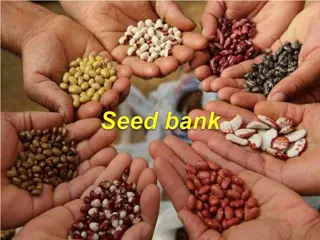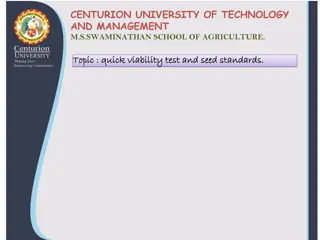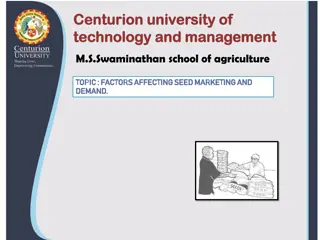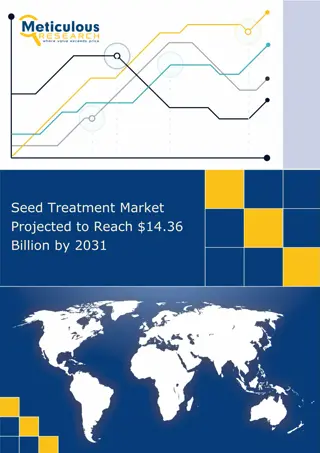Importance of Seed Marketing in Seed Industry
Seed marketing is a crucial component of seed technology, encompassing various activities from production to sales. It involves demand forecasting, marketing structure, storage arrangements, promotional activities, post-sales service, and pricing economics. Realistic demand forecasts are essential to prevent overstocks or shortages, ensuring stable prices and profits. Factors like cultivated acreage, extension efforts, cultivator preferences, competition, and effective promotion strategies must be considered when making demand forecasts.
Download Presentation

Please find below an Image/Link to download the presentation.
The content on the website is provided AS IS for your information and personal use only. It may not be sold, licensed, or shared on other websites without obtaining consent from the author.If you encounter any issues during the download, it is possible that the publisher has removed the file from their server.
You are allowed to download the files provided on this website for personal or commercial use, subject to the condition that they are used lawfully. All files are the property of their respective owners.
The content on the website is provided AS IS for your information and personal use only. It may not be sold, licensed, or shared on other websites without obtaining consent from the author.
E N D
Presentation Transcript
Seed Marketing-Different Marketing Channels
SEED MARKETING Seed marketing is one of the most vital components of seed technology. On it depends the size and scope of the seed industry.
Broadly it includes such activities as production, processing, storage, quality control and marketing of seeds. In the narrow sense, however; seed marketing refers to the actual acquisition and selling 'of packed seeds, intermediate storage, delivery and sales promotional activities.
Seed marketing comprises the following: 1) Demand forecasts 2) Marketing structure. 3) Arrangements for storage of seeds. 4) Sales promotional activities. 5) post-sales service. 6) Economics of seed production and seed pricing.
Demand Forecast: Realistic assessment and targets of seed demand are very necessary. Excessive quantities result in large carry- over stocks and subsequent losses, due to loss in germination and vigour of seeds, if carried over for too long. On the other hand, short supplies would deprive the seed company.
The main principle lying under the forecast should be that seed supply kept pace with seed demand (both present & future) in terms of quantity, quality ,price, place and time. Planned seed programme would avoid gluts and shortages and ensures stable prices and profits.
In making demand forecasts, the following factors must be considered carefully : (a) Total cultivated acreage, seed rate, quality replacement period and assessment of total potential seed requirement of each of the important crops. (b) Impact of extension efforts on the introduction of improved production techniques, and future plans for promotion. (c) Current acreage under high yielding varieties and amount of seed sold. in the last year.
(d) Cultivator preferences for .varieties, package size, kind of packing" quality and price. (e) Number and size of competitors. (f) Kinds of publicity and sales promotion that are most effective.
Marketing Structure : (Establishment of effective channel for seed distribution) The key to success in seed marketing is the establishment of effective channel of distribution. The various channels through which seed can be marketed vary greatly according to the needs of the seed company.
Present status of seed distribution: The types of seed distribution systems in India are: (a) Farmer to farmer distribution. This is the traditional where by farmers obtain their requirements from neighbours either on cash payment or on an exchange basis. No formal marketing organization is required for this type of distribution. (b) Distribution by co-operatives. This involves procurement of seeds by cooperatives and its subsequent distribution. The distribution of seeds through cooperatives has often been en-couraged by the government through subsidies and guarantees.
(c) Distribution by Departments of Agriculture. Seeds are purchased by the government, out of the government funds, and are distributed through district Agricultural Officers and Block Development Officers. (d) Distribution of seeds by non-government or quasi government agencies. In this system, the seeds are distributed through a network of seed distributors and seed dealers.
Marketing organization There are a number of possible ways in which a marketing network could be organised. The simplest and most efficient system is to establish a central marketing cell and regional officcess in end use areas. The retail sale could be organised either by appointing distributors/dealers such as private dealers. Cooperatives, agro-sales service centre's etc., or by opening seed company/corporation owned sales points.
The central marketing cell is responsible for planning, appointment of dealers/distributors, seed move-ment, marketing intelligence research, pricing, promotional activities, financing and record keeping. The regional offices are responsible for seed supply and promotional materials to dealers/distributors, training of seed dealers, expansion into new market areas, publicity and execution of promotional programmers.
Arrangements of storage of seeds Need to be arranged seed stores at grass root level
Promotional Media (a) Newspapers (b) Cinema slides (c) Hoardings (d) Radio (e) Melas. (f) Field demonstrations
After-sales or post-sales service - Refers to the processes that ensure your customers are satisfied with the products and services that have been supplied. - Always reach out to customers asking for feedback on the product and service so you can make it better next time.
Pricing policy - The effective price , of a product which is prefixed or set before launching it to market. - it might also change in response to competition & to the general market situation .























